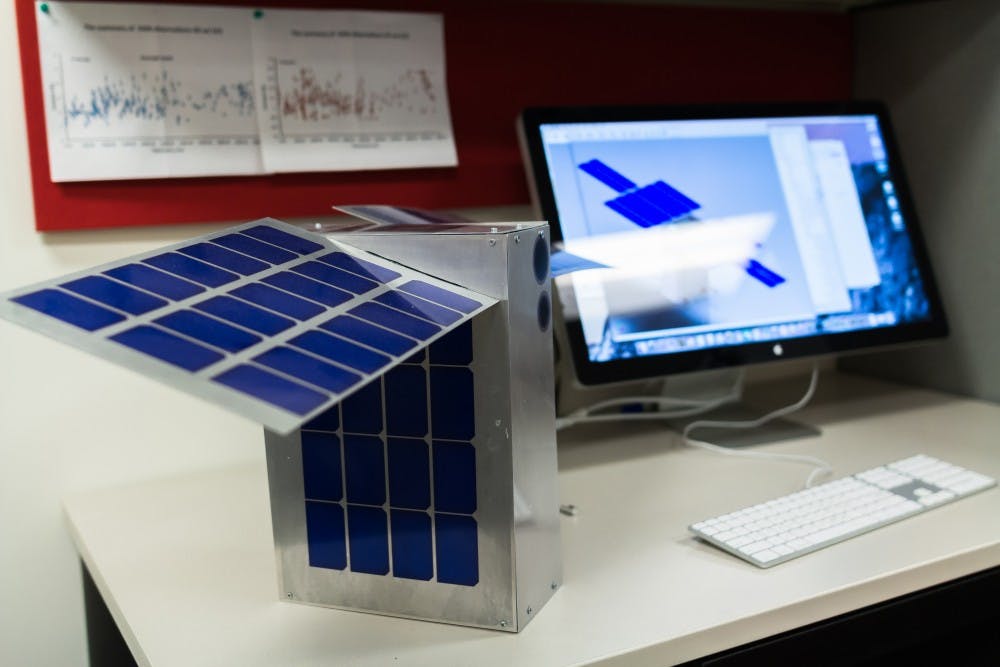It's difficult to imagine a shoebox on the forefront of scientific discovery.
However, that's exactly what a group of researchers at ASU's School of Earth and Space Exploration is doing.
The team is designing and will operate a small, shoebox-sized satellite called a CubeSat following NASA's acceptance of their proposal to contribute the satellite to an expedition flown by the space agency's newest rocket, the Space Launch System, according to NASA's website.
ASU's craft is called LunaH-Map, short for the Lunar Polar Hydrogen Mapper, and it seeks to map the moon's water deposits, especially at the southern pole, Hannah Kerner, a SESE graduate student and lead systems and software engineer on the LunaH-Map project, said.
The satellite will fly low above the surface of the moon, using neutron detectors to count the amount of neutrons dislodged into space by cosmic rays. Different counts and energies of the neutrons that escape from the moon are characteristic of different elements being present, she said.
Kerner said the application for ASU to work on this project was not a simple one.
"So, when you submit a proposal, you really have to convince NASA, one, that this fits into their long term goals for planetary science ... and you have to convince them that the mission is technically feasible," she said. "First you have to prove that you can create an instrument that will do the science and that the science is valuable."
The scientific community has already agreed that there is water present on the moon. However, finding out the volumes and locations of these deposits is important to determine how the moon, the earth and other planetary bodies formed, and is helpful in shaping plans for future space exploration, Kerner said.
With this project, ASU will be with NASA at the frontier of space exploration.
"This is the first interplanetary CubeSat that will be launched," she said. "So for a student to be able to work on that, it's not just a rare opportunity for a student, it's a once-in-a-lifetime opportunity for anyone."
Robert Amzler, an aerospace junior and the mechanical and thermal lead on the LunaH-Map project, is one such student. He's been working on the project since November.
He does mechanical modeling, computer design, as well as analysis of how different components will affect heat in the satellite, he said.
Amzler said it's a great opportunity to get real world skills that I'm gonna be using in the space industry.
"And because it's a University project, they let undergrads do things that wouldn't normally be assigned to undergrads," he said. "It's awesome being one of the first CubeSats to go to the moon. It's basically working on a part of space history."
The LunaH-Map project is part of a broader NASA mission to develop the infrastructure and resources to get humankind to Mars. The Space Launch System rocket will carry 13 CubeSats in total as well as the Orion spacecraft, which will be unmanned for this mission.
The first launch is being targeted for 2018, said Kathryn Hambleton, a media relations specialist at NASA.
Since the rocket will be unmanned, it will be able to carry all of the CubeSats, which will depart from the rocket after it separates, she said.
Each will perform different purposes — mapping the environments of the moon, deep space, analyzing radiation and more.
They all fit within NASA's four different focus areas: aeronautics, science, technology and human exploration.
Eventually, the information gathered from this expedition will be used to help facilitate human exploration to Mars and beyond, she said.
"This is the rocket that will enable our journey to Mars as we expand our human presence into the solar system," Hambleton said.
Related Links:
ASU scientists to research with NASA’s new Telescope
ASU professor discusses NASA mission to Jupiter moon
Reach the reporter at Arren.Kimbel-Sannit@asu.edu or follow @akimbelsannit on Twitter.
Like The State Press on Facebook and follow @statepress on Twitter.




